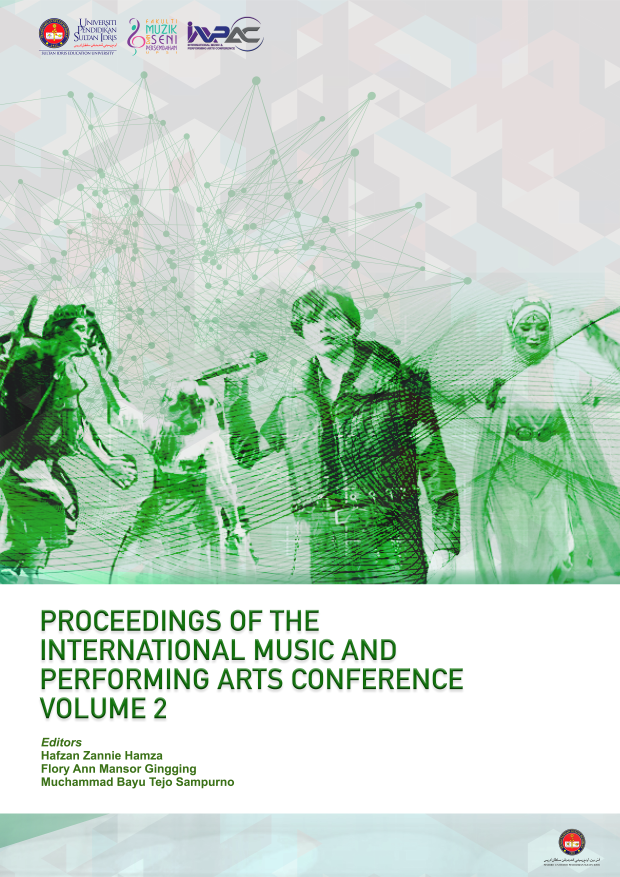Performing Identities in Flux: The Erhu as a Cultural Mediator in the Dynamics of Tradition, Modernity, and Globalization
DOI:
https://doi.org/10.37134/impac.v2.17.2024Keywords:
cultural mediator, erhu, globalization, modernity, traditionAbstract
Erhu, as one of the representatives of traditional Chinese bowstring instruments, has long been a symbol of Chinese cultural heritage. However, in the context of the rapid development of modernization and globalization, its role has been greatly impacted and transformed. Considering the ongoing academic debate on the future development of erhu performance, this paper constructs a theoretical model, the Erhu Cultural Mediation Framework, to explore the mediating role of the erhu in the intersection of tradition, modernity, and globalization. This theoretical model challenges the static concept of cultural identity, showing that the erhu is a place where different cultures encounter, and its cultural identity is constantly reconstructed in each performance. By situating the erhu within a discussion of identity, performance, and globalization, this paper provides a new theoretical perspective for understanding how traditional music adapts to the forces of modernity and globalization, and mediates the tension between preserving heritage and embracing the effects of globalization. Therefore, the Erhu Cultural Mediation Framework provides a valuable way to examine the complexity of cultural identity in the era of globalization and provides a research basis for other traditional arts in similar situations.
Downloads
References
Bhabha, H. (1994). The location of culture. Routledge.
Butler, J. (1990). Gender trouble: Feminism and the subversion of identity. Routledge.
Doku, P. N., & Asante, K. O. (2011). Identity: Globalization, culture, and psychological functioning. Journal of Human Sciences, 8(2), 294-301.
Hei, T. (2018). Erquan yingyue [Moon reflected on second spring]. Guangxi: Guangxi Shifan Daxue Chubanshe.
Hu, X., & Liu, D. (2024). Historic value of the music creation of Shaanxi Erhu works and positive influence of Shaanxi Erhu on the development of Erhu art in the Yu and Qin schools. Cultura. International Journal of Philosophy of Culture and Axiology, 21(3), 206.
Li, Z. S. (2006). Erhu art and Jiangnan culture [Unpublished doctoral dissertation]. Fujian Normal University. https://kns.cnki.net/KCMS/detail/detail.aspx?dbname=CDFD9908&filename=2006180566.nh
Lv, Y. J. Y., Li, J., Feng, X. H., Zeng, J. C., & Qiao, J. L. (2021). Jin Wunian Yilaide Erhu Yinyue Lilun Wenxian Zongshu (2016-2020) [Literature review of Erhu music theory in recent five years (2016-2020)]. Zuojia Tiandi, 26, 143–144. cnki:SUN:ZJTD.0.2021-26-073
Powell, J. L. (2014). Globalization and modernity. International Letters of Social and Humanistic Sciences, 28, 1–60. https://doi.org/10.18052/www.scipress.com/ilshs.28.1
Qiao, J. Z. (2000). Yijian yueqi he yige shiji—Erhu yishu bainianguan [An instrument and a century—A centennial view of Erhu art]. Yinyue yanjiu, 1, 36-44. https://doi.org/CNKI:SUN:MUSI.0.2000-01-005
Ru, Y. (2008). Cong Wang Jianmin de Erhu Kuangxiangqu kan Tade Chunagzuolinian yu Yinyuetezhi [From the Erhu rhapsody of Wang Jianmin to see his creative ideas and musical characteristics]. Zhongguo Yinyue, 03, 219–221. cnki:SUN:ZGMU.0.2008-03-056
Stock, J. (1993). A historical account of the Chinese two-stringed fiddle Erhu. The Galpin Society Journal, 46, 83–113. https://doi.org/10.2307/842349
Stuart, H., & Hall, D. M. (1990). Essential essays, volume II: Identity and diaspora. Duke University Press.
Tong, M., & Ji, C. (2024). The application and innovation of Erhu music in modern popular music. Applied Mathematics and Nonlinear Sciences, 9(1). https://doi.org/10.2478/amns-2024-1664
Wang, J. Y. (1997). Qingdai heshi you Erhu [When was there an Erhu in Qing Dynasty]. Jiling Yishu Xueyuan Xuebao, 1, 58–59. cnki:SUN:JLYY.0.1997-Z1-014
Wang, X. N. (2017). Dui dangxia zhongguo minzuyinyue zhutiyishi de sikao [Reflections on the subject consciousness of current Chinese folk music]. Nanjing Yishuxueyuan Xuebao, 4, 116-120.
Xiao, M. (2020). Biaoyanzhe: zai lishi yu dangxia de shizi lukou [Performer: At the crossroads of history and present]. Yinyue Yishu, 3, 6-22. https://doi.org/10.19359/j.cn31-1004/j.2020.03.001
Xiao, M. (2020). Minzu qiyue de chauntong yu dangdai yanyi [Traditional and contemporary interpretation of ethnic instrumental music]. Zhongguo Yinyuexue, 2, 74-91. https://doi.org/10.14113/j.cnki.cn11-1316/j.2020.02.010
Xiaoyu, H., & Dongxing, L. (2023). Relation between the formation of Erhu styles and cultural conditions of Yu School and Qin School in contemporary China. Journal of Namibian Studies: History Politics Culture, 33, 3432-3446.
Xie, H. H. (2018). Qianxi woguo Erhu wenhua de lishi yu fazhan [Brief analysis of the history and development of Chinese Erhu culture]. Renwen Tianxia, 3, 73-76. https://doi.org/10.16737/j.cnki.rwtx81281190.2018.03.013
Yu, H. (2004). Liu Tianhua yinyue shengya [Liu Tianhua's music career]. Beijing: Renmin Yinyue Chubanshe.
Zhang, S. (2010). Erhu as violin: Development of China’s representative musical instrument, c. 1990-2008.
Downloads
Published
Issue
Section
License
Copyright (c) 2024 Wang Xizhong, Camellia Siti Maya Mohamed Razali (Author)

This work is licensed under a Creative Commons Attribution 4.0 International License.
Authors retain copyright and grant the Proceedings of the International Music and Performing Arts Conference (IMPAC Proceedings) the right of first publication.
This licence permits unrestricted use, distribution, and reproduction in any medium, provided the original work is properly cited.




